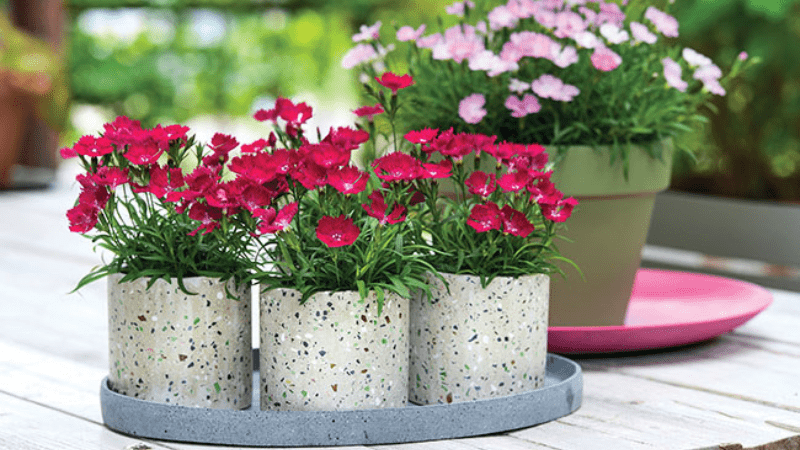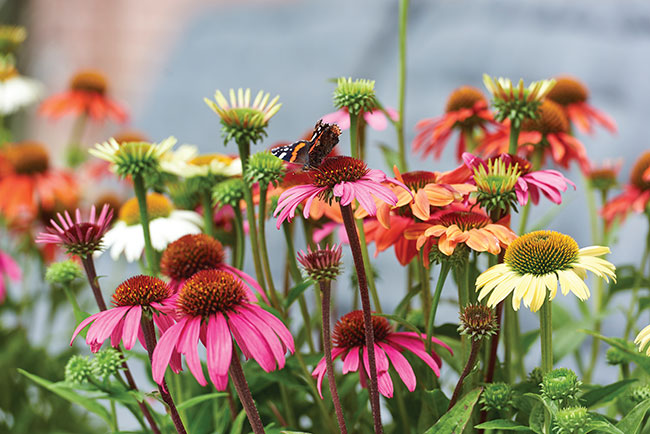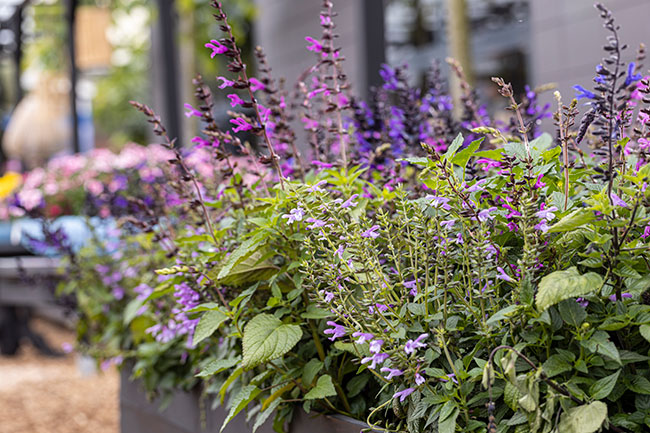
Breeding innovations
New variety introductions and annual plant trials give us great insight into what genetics work best for different regions of the U.S. every year. This is especially important as environmental conditions continue to change nationwide. Plant breeders rely on this feedback to improve varieties, while growers and retailers use this information to determine what new plants should be added to or removed from their production. None of this would be possible without plant breeding and the technologies that continue to be developed to produce the varieties that keep our industry thriving.
ADVANCES IN BREEDING WORK
There have been many advances in breeding technology over the years, including the development of new techniques for improving the genetics and characteristics of new varieties. The HilverdaFlorist team is focusing on innovation and optimization to breed more sustainably and with greater precision to meet the needs of the market.
At Danziger, “One area we are focusing on covers several crops,” says Mike Fernandez, market manager at Danziger North America. “We’re working to duplicate desirable traits and habits in existing lines for a more uniform series. This is exciting because it makes it easier for growers to produce a reliably consistent crop.
“Our overall goal is to produce quality varieties that offer consistent and reliable production for our customers. If we can make them more successful, everyone wins.”
Jonathan Pedersen, president and CEO at Monrovia, says, “We are focused on working with breeders to introduce plants that help give consumers confidence and make it easy for them to be successful. As we sell across the country, there are many plants that we can offer with performance improvements especially regarding environmental conditions.”
CROP FOCUS
Characteristics like heat tolerance, disease resistance, continuous blooms, and uniform growth habit are commonly described when looking at new variety descriptions and trial results. With so many important factors to consider, breeders are making improvements best suited for a multitude of landscapes and regions.
Danziger continues to focus its breeding efforts on what Fernandez says are main crops that are most important to the industry, such as calibrachoa, petunia and verbena. “We are also working on some of our lines that have been around for a while, continuing to improve habit, disease resistance, bloom power and lower PGR use,” he says.
Drought-tolerant plants are essential for many places in the country, not only in the West. “We are also working on the invasive plant issue, looking for sterility in many problem genus; and we are always looking for reduced plant size as home yards continue to shrink,” Pedersen says. Research has shown Monrovia that home gardeners are looking for longer flowering times or reblooming plants, so that makes it a priority to provide that attribute in new introductions. Monrovia is also working on improving fragrance, as many plants have had this trait bred out of them over the years.
HilverdaFlorist has a wide range of pot, patio, and garden varieties in alstroemeria, dianthus, echinacea, gerbera, helleborus and salvia. “The assortment consists of crops that have been bred for decades to relatively new products. Products that are recently presented to the market require different attention compared to the crops that have been around for a longer time,” says Cheryl Zethof, marketing coordinator at HilverdaFlorist.
Gerbera and dianthus are crops that have been part of the product range for decades, including the world’s first true, hardy garden gerbera: Garvinea. “The breeders of HilverdaFlorist have been working on these varieties for years. As a result of the high level of performance of these crops, improvements might sometimes be relatively small, but certainly not less important. With crops like these, HilverdaFlorist focuses on improvement by consolidation,” Zethof says.
With new series such as echinacea MOOODZ, salvia Salgoon and helleborus, the focus is on fundamental aspects and establishing these crops in the market, creating opportunities for potential growth, says Zethof. The introduction of new, improved crops is important for HilverdaFlorist, with its team of breeders constantly looking for new opportunities to diversify and differentiate.

CHALLENGES
Breeding takes a lot of time and effort and there are always challenges to overcome within the process. While the biggest challenges in breeding have not changed all that much over the years, there is always pressure to come up with something new and exciting, says Pedersen.
“There is less breeding happening at the university level, and I do see this as a potential challenge in the future. Fewer doctoral candidates are working on ornamental crops and there is less work being done for some of the issues that are important to our industry — especially around pest and disease issues,” Pedersen says.
Fernandez agrees that one of the biggest challenges as a breeder is coming up with a “game changer” variety that everyone is looking for. “It is almost expected that breeders deliver a stunning ‘new’ product every year, when in reality, those types of varieties take multiple years — sometimes even longer — to develop,” he says.
At HilverdaFlorist, sustainability is currently an important topic, including improving genetic resilience — a sustainable solution to deal with the increasing pressure of diseases and pests. “HilverdaFlorist strives to develop robust plants that can withstand various circumstances and survive even longer with fewer resources. It is important to work more from a sustainability and resilience perspective.
“When working toward more sustainable products, there are of course challenges. Working on genetic resistance takes a lot of time, and bioassays often are difficult, since they can give a lot of variation. But, nonetheless, it is something we focus on and strive to optimize,” Zethof says.

FUTURE PLANS
Breeding new varieties can take years from start to finish, so it’s crucial for breeders to continue to have plants in the pipeline.
Danziger will continue to focus on improved shelf life, drought tolerance and heat tolerance, as well as lower chemical use in its breeding work, says Fernandez.
HilverdaFlorist plans to continue working on optimizing outdoor growth for many of its series, including improvements to resistance to diseases and pests, and stress factors. “HilverdaFlorist is working on genetic compactness, which can have important implications for plant growth and development, as well as for the plant’s ability to adapt to different environmental conditions. This is done without the use of PGR treatments. To achieve this, more outdoor trials are being set up so robustness and resilience in the crops can be better selected,” Zethof says.

TECHNOLOGY
Some breeders are using traditional methods without gene insertion or extraction, while others are working with more advanced technologies.
“Technology is changing how breeding is accomplished. It is having a large impact on our industry and brings new and exciting genetics to market more quickly than ever before,” Fernandez says. There are currently developments with marker-assisted breeding, a technique that uses molecular markers to identify and select plants with desirable characteristics. HilverdaFlorist will use this technology to identify markers, then use it to breed plants with the desired characteristics, making it possible to produce plants with improved characteristics — such as disease resistance — more efficiently and effectively.
Genetics are constantly being improved with the goal of increasing overall garden performance and uniformity. Breeders will no doubt continue to provide new and improved varieties year after year and work to develop more promising varieties for the future of our industry.
For an enhanced reading experience, view this article in our digital edition by clicking here.


 Video Library
Video Library 




















